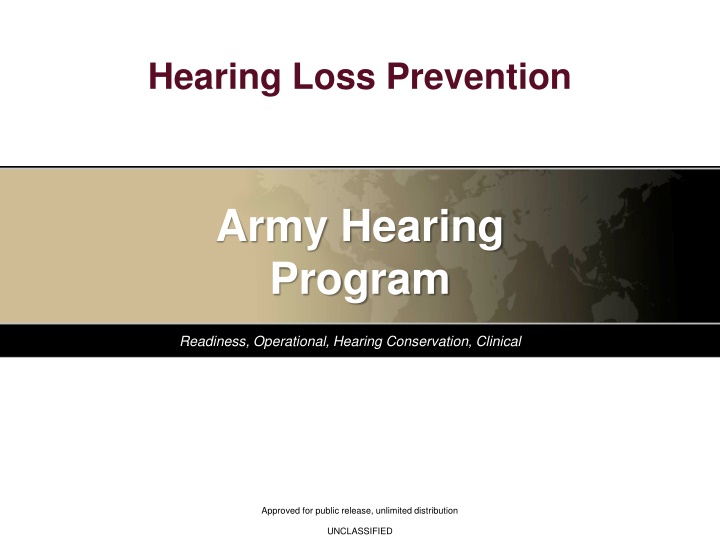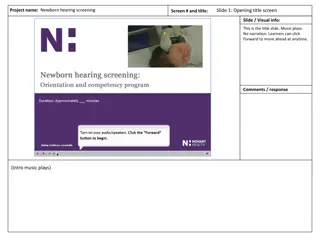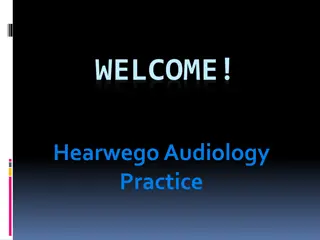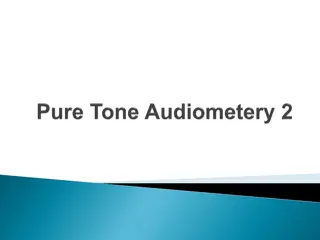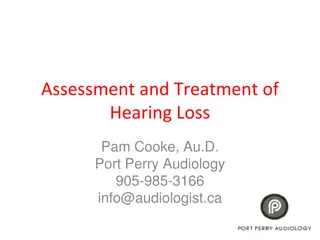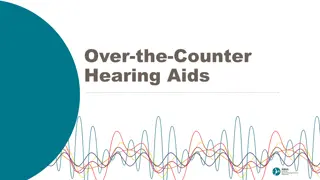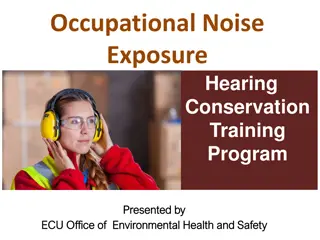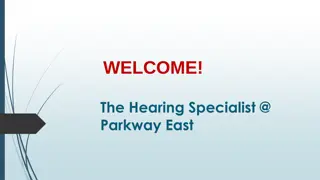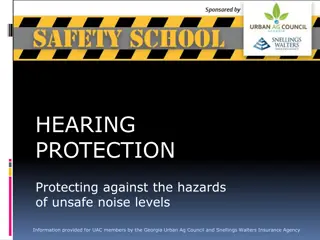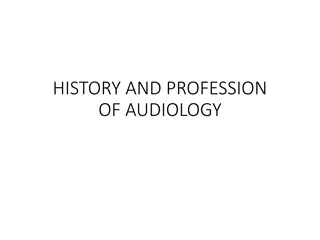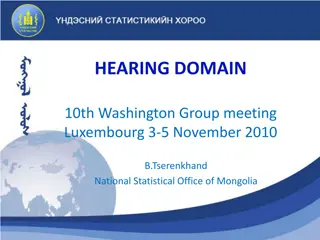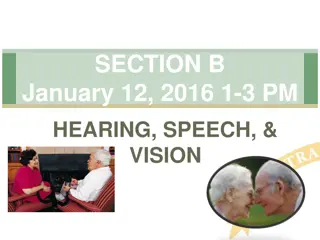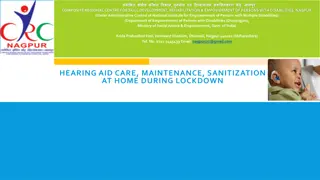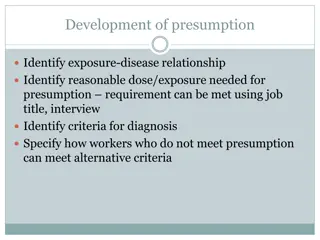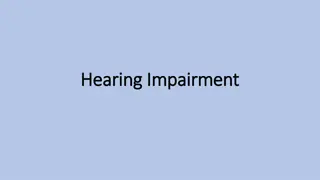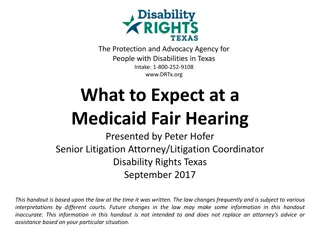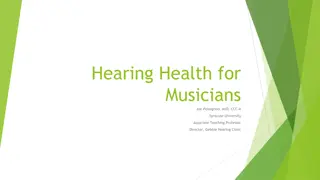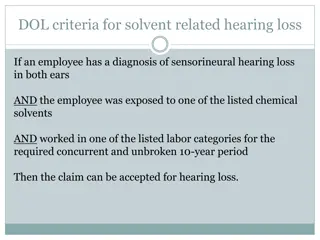Protect Your Hearing: Strategies for Prevention
Strategies for minimizing noise-related threats in operational environments are crucial to prevent permanent hearing loss. Understanding the risks of loud noise exposure, utilizing hearing protection, undergoing regular audiometric testing, and maintaining noise records are essential components of the Army Hearing Program. Consistent exposure to loud noise can lead to irreversible nerve damage, causing gradual hearing loss and potential tinnitus. Recognizing the consequences of hearing loss, such as difficulty hearing speech in noisy environments, underscores the importance of proactive prevention measures.
Download Presentation

Please find below an Image/Link to download the presentation.
The content on the website is provided AS IS for your information and personal use only. It may not be sold, licensed, or shared on other websites without obtaining consent from the author.If you encounter any issues during the download, it is possible that the publisher has removed the file from their server.
You are allowed to download the files provided on this website for personal or commercial use, subject to the condition that they are used lawfully. All files are the property of their respective owners.
The content on the website is provided AS IS for your information and personal use only. It may not be sold, licensed, or shared on other websites without obtaining consent from the author.
E N D
Presentation Transcript
Hearing Loss Prevention Army Hearing Program Readiness, Operational, Hearing Conservation, Clinical Approved for public release, unlimited distribution UNCLASSIFIED
BRIEFING OUTLINE PURPOSE: To provide strategies for effectively minimizing noise- related threats on and off the job. 1. Hearing & Noise 2. Hazardous Noise Levels 3. Hearing Protection 4. Audiometric (hearing) testing 5. Noise records (your rights) 6. Conclusion UNCLASSIFIED
Noise Exposure Threat Permanent Hearing Loss = Top Four Injuries in Current Operational Environment Exposure to loud noise will cause hearing loss over time Hearing Loss is an injury that occurs without pain No sensory nerves in the inner ear (cochlea) Gradual or Sudden no way to predict who is susceptibility to loss Always Cumulative Tinnitus, or permanent ringing in the ear UNCLASSIFIED
Response to the threat of loud noise: The Army Hearing Program Readiness, Operational, Hearing Conservation, Clinical Prevention & Education are Key Understand the threat of loud noise Employ strategies to minimize the threat UNCLASSIFIED
Exposure to Noise over Time Our ears can recover from short exposure to loud noise but, over time, permanent nerve damage will occur The longer and louder the noise, the greater the chance permanent damage will occur Ears do not get used to the noise UNCLASSIFIED
CONSEQUENCES OF HEARING LOSS Hearing loss from noise exposure is gradual and usually not noticed at first Hearing loss from noise affects your ability to hear higher pitches first (speech sounds such as s, f, th, z ) Often, the first noticeable effect of hearing loss is difficulty hearing speech in noisy environments UNCLASSIFIED
HEARING AND NOISE Hearing Nerve Noise = Vibrating Air Molecules Ear Drum Damage! Diagram Courtesy of Troels Loyborg UNCLASSIFIED
INSIDE THE COCHLEA Hair Cells Damaged by Noise (Hearing Nerve Endings) Healthy Hair Cells (Hearing Nerve Endings) Damage! UNCLASSIFIED
Tinnitus from Noise Exposure Exposure to high noise levels can also cause permanent ringing or noise in the ear called tinnitus Tinnitus sufferers usually complain of constant whistling, squealing, roaring, or buzzing in one or both ears Severe tinnitus may disrupt sleep, reduce concentration, and cause irritability or depression UNCLASSIFIED
HAZARDOUS NOISE LEVELS Noise Levels which Cause Hair Cell Damage: Steady-state Noise > 85 dBA Steady-state Noise = Noise > second in duration Most generators Rotary wing aircraft Lawn mowers, jack hammers, circular saws Tends to cause gradual hearing loss Impulse/Impact Noise >140 dBpSPL Explosions All Weapons Can be gradual or sudden hearing loss Photo Courtesy of US Navy UNCLASSIFIED
Noise Level Examples Fire crackers, weapons fire .140 dB+ Jack hammer ..130 dB Jet plan . 120 dB Rock concert ..........................110 dB Snow mobile, chain saw ..100 dB Tractor 95 dB Lawn mower, motor cycle 90 dB Busy Traffic .70 dB Normal Conversation ..60 dB Quiet room . 40 dB Whisper .30 dB LOUD SOFT UNCLASSIFIED
HAZARDOUS NOISE LEVELS Three Foot Rule (For Steady State Noise) If the sound is so loud that you must raise your voice to be understood at a distance of three feet it is POTENTIALLY HAZARDOUS Fact: The exposure to engine noise in a 4-hour convoy can be as damaging to hearing as one IED UNCLASSIFIED
HEARING PROTECTION Earplugs Pre-formed Single Flange Triple Flange Quad Flange Combat Arms Earplugs Hand-formed (foam) Proper Fit: Pull Back on Ear to Straighten Ear Canal Vacuum Seal hollow sounding or like you have a head cold Earmuffs Adjust headband for a snug fit Combat Arms Flattened switch for engines, generators, vehicles Open switch for metal-on-metal, weapons fire UNCLASSIFIED
Hows the fit? Triple Flange Earplugs with Insertion Tool 2 1 3 UNCLASSIFIED
Hows the fit? 2 Bi-Colored Foam Earplug 1 3 UNCLASSIFIED
Hearing Protection in Background Noise Using earmuffs or plugs in noisy areas can actually make it easier to hear coworkers or machinery Hearing protectors reduce loud background noise; decreasing worker stress from noise, and improving communication Photo Courtesy of CDC PHIL UNCLASSIFIED
Audiometric (Hearing)Testing Establish individual fitness for duty Detect changes in hearing early Ensure proper medical referrals and diagnoses Monitor the effectiveness of the local hearing program to keep employees safe Comply with Federal regulations (OSHA) UNCLASSIFIED
Audiometric Testing Audiometric testing results can be used to check the following: The adequacy of hearing protection being used A diagnostic hearing evaluation determines whether a hearing loss is present, the type of hearing loss, and whether a referral to a medical doctor is necessary UNCLASSIFIED
Noise Measurements Noise measures are made to evaluate the potential for an exposure to cause hearing loss A person s total involvement with noise, not just a momentary level Noise Level, dBA Permitted daily exposure time 85 8 HOURS 88 4 HOURS 91 2 HOUR 94 1 HOUR 97 30 MINUTES 100 15 MINUTES 103 7.5 MINUTES UNCLASSIFIED
Recordkeeping Employers are required by OSHA to keep all records involving noise measurements for at least two years Employers are required by OSHA to keep any information regarding employee testing and training for the duration of employment OSHA also requires the employer to maintain records of any employee who is documented to have a decrease in hearing UNCLASSIFIED
CONCLUSION Noise induced Hearing Loss is NOT inevitable Using hearing protection is crucial to preventing hearing loss The ability to understand speech increases when background noise is reduced You have the right to see noise measurement records and get copies of your hearing test results UNCLASSIFIED
Hearing Loss is: Painless Permanent Progressive Preventable! UNCLASSIFIED
